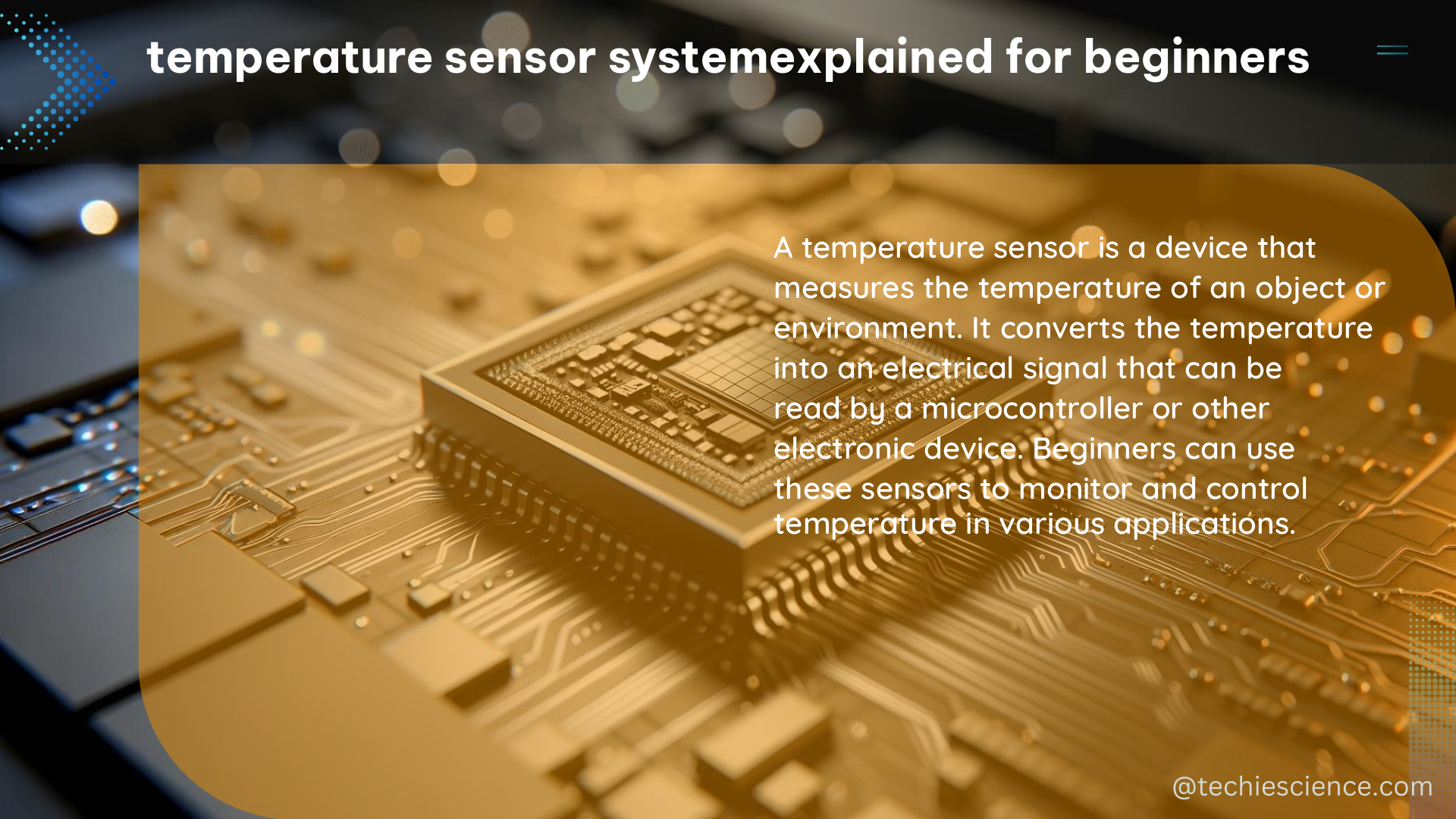Temperature sensor systems are essential for measuring temperature in various applications, from industrial processes to home automation. This comprehensive guide will provide a detailed explanation of temperature sensor systems for beginners, focusing on their technical specifications, working principles, and DIY aspects.
Understanding Temperature Sensors
Temperature sensors are devices that measure the temperature or temperature gradient by detecting changes in temperature. They come in various types, each with its own advantages, disadvantages, and optimal temperature ranges. Let’s explore the most common types of temperature sensors:
Resistance Temperature Detectors (RTDs)
RTDs are temperature sensors that measure temperature by changes in the resistance of a fine metal wire, typically made of platinum, copper, or nickel. They are highly accurate, with an accuracy of ±0.1°C, and have a wide operating range of -200°C to 1000°C. RTDs are easy to install and provide a linear output, making them suitable for a variety of applications.
Technical Specifications:
– Temperature range: -200°C to 1000°C
– Accuracy: ±0.1°C
– Response time: 1 second
– Typical resistance: 100 Ohms at 0°C (PT100)
Thermocouples
Thermocouples consist of two different metals joined together that generate a voltage proportional to the temperature. They are inexpensive, rugged, and have a wide temperature range of -200°C to 2000°C, but are less accurate than RTDs, with an accuracy of ±2°C. Thermocouples are commonly used in industrial applications, such as furnaces and ovens, due to their durability and wide temperature range.
Technical Specifications:
– Temperature range: -200°C to 2000°C
– Accuracy: ±2°C
– Response time: 0.1 second
– Common types: Type K, Type J, Type T, Type E
Thermistors
Thermistors are temperature-sensitive resistors that change resistance with temperature. They are highly accurate, with an accuracy of ±0.1°C, and have a fast response time of 0.01 second. However, they have a limited temperature range of -90°C to 150°C and a non-linear output, which requires additional circuitry for linearization.
Technical Specifications:
– Temperature range: -90°C to 150°C
– Accuracy: ±0.1°C
– Response time: 0.01 second
– Resistance change: Typically 3-6% per °C
Infrared Temperature Measurement
Infrared temperature measurement systems use electromagnetic radiation to measure temperature without contact. They are ideal for measuring moving or overheated objects and objects in hazardous environments. Infrared sensors are non-destructive and provide very fast response times of 10 milliseconds, with an accuracy of ±1°C. They can measure temperatures ranging from -30°C to 3000°C.
Technical Specifications:
– Temperature range: -30°C to 3000°C
– Accuracy: ±1°C
– Response time: 10 milliseconds
– Typical applications: Machinery, furnaces, electrical equipment
Interfacing Temperature Sensors with PLCs

Temperature sensor systems can be interfaced with Programmable Logic Controllers (PLCs) for automation and control applications. PLCs can read temperature sensor data and make decisions based on temperature thresholds. For example, a PLC can turn off a heater if the temperature exceeds a certain limit, or activate a cooling system if the temperature rises above a set point.
The process of interfacing temperature sensors with PLCs typically involves the following steps:
1. Selecting the appropriate temperature sensor based on the application requirements, such as temperature range, accuracy, and response time.
2. Connecting the temperature sensor to the PLC’s input module, which can be an analog or digital input depending on the sensor type.
3. Configuring the PLC’s software to read the temperature sensor data and perform the desired control actions based on the temperature thresholds.
4. Implementing safety measures, such as temperature alarms and emergency shutdown procedures, to ensure the system operates within safe limits.
DIY Temperature Sensor Systems
DIY temperature sensor systems can be built using off-the-shelf components or custom-designed circuits. These systems can be used for a variety of applications, such as home automation, environmental monitoring, and scientific experiments.
One example of a DIY temperature sensor system is a thermistor-based temperature sensor using an Arduino microcontroller. The setup involves the following components:
– Arduino microcontroller
– Thermistor
– Resistors
– Wiring
The Arduino can read the thermistor resistance and convert it to temperature using a basic formula. This type of DIY temperature sensor system can be easily customized and integrated with other Arduino-based projects, such as data logging, temperature control, and remote monitoring.
Another DIY option is to use a digital temperature sensor, such as the DS18B20 or the DHT11, which can be directly interfaced with the Arduino or other microcontrollers. These sensors provide a digital output, simplifying the interfacing process and eliminating the need for analog-to-digital conversion.
When building DIY temperature sensor systems, it’s important to consider factors such as sensor accuracy, response time, and temperature range to ensure the system meets the specific requirements of the application.
Conclusion
Temperature sensor systems are essential for measuring temperature in a wide range of applications, from industrial processes to home automation. By understanding the different types of temperature sensors, their technical specifications, and the process of interfacing them with PLCs and DIY systems, you can select the most appropriate solution for your needs and create customized temperature monitoring and control systems.
References:
- Temperature Measurement – MST.edu
- The Complete Guide to Temperature Sensors – SolisPLC
- Basics of non-contact temperature measurement – More Precision
- What is Quantitative Data? [Definition, Examples & FAQ] – CareerFoundry

The lambdageeks.com Core SME Team is a group of experienced subject matter experts from diverse scientific and technical fields including Physics, Chemistry, Technology,Electronics & Electrical Engineering, Automotive, Mechanical Engineering. Our team collaborates to create high-quality, well-researched articles on a wide range of science and technology topics for the lambdageeks.com website.
All Our Senior SME are having more than 7 Years of experience in the respective fields . They are either Working Industry Professionals or assocaited With different Universities. Refer Our Authors Page to get to know About our Core SMEs.